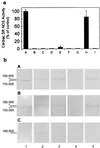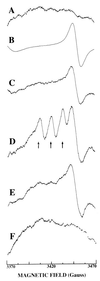Nitric oxide synthase in cardiac sarcoplasmic reticulum
- PMID: 9892689
- PMCID: PMC15192
- DOI: 10.1073/pnas.96.2.657
Nitric oxide synthase in cardiac sarcoplasmic reticulum
Abstract
NO. is a free radical that modulates heart function and metabolism. We report that a neuronal-type NO synthase (NOS) is located on cardiac sarcoplasmic reticulum (SR) membrane vesicles and that endogenous NO. produced by SR-associated NOS inhibits SR Ca2+ uptake. Ca2+-dependent biochemical conversion of L-arginine to L-citrulline was observed from isolated rabbit cardiac SR vesicles in the presence of NOS substrates and cofactors. Endogenous NO. was generated from the vesicles and detected by electron paramagnetic resonance spin-trapping measurements. Immunoelectron microscopy demonstrated labeling of cardiac SR vesicles by using anti-neuronal NOS (nNOS), but not anti-endothelial NOS (eNOS) or anti-inducible NOS (iNOS) antibodies, whereas skeletal muscle SR vesicles had no nNOS immunoreactivity. The nNOS immunoreactivity also displayed a pattern consistent with SR localization in confocal micrographs of sections of human myocardium. Western blotting demonstrated that cardiac SR NOS is larger than brain NOS (160 vs. 155 kDa). No immunodetection was observed in cardiac SR vesicles from nNOS knockout mice or with an anti-nNOS mu antibody, suggesting the possibility of a new nNOS-type isoform. 45Ca uptake by cardiac SR vesicles, catalyzed by Ca2+-ATPase, was inhibited by NO. produced endogenously from cardiac SR NOS, and 7-nitroindazole, a selective nNOS inhibitor, completely prevented this inhibition. These results suggest that a cardiac muscle nNOS isoform is located on SR of cardiac myocytes, where it may respond to intracellular Ca2+ concentration and modulate SR Ca2+ ion active transport in the heart.
Figures




Similar articles
-
Lack of nitric oxide synthase depresses ion transporting enzyme function in cardiac muscle.Biochem Biophys Res Commun. 2002 Jun 28;294(5):1030-5. doi: 10.1016/S0006-291X(02)00599-5. Biochem Biophys Res Commun. 2002. PMID: 12074580
-
Cardiac neuronal nitric oxide synthase isoform regulates myocardial contraction and calcium handling.Circ Res. 2003 Mar 21;92(5):e52-9. doi: 10.1161/01.RES.0000064585.95749.6D. Epub 2003 Mar 6. Circ Res. 2003. PMID: 12623875
-
Protective role of nitric oxide synthase against ischemia-reperfusion injury in guinea pig myocardial mitochondria.Eur J Pharmacol. 1999 Sep 3;380(1):37-48. doi: 10.1016/s0014-2999(99)00531-2. Eur J Pharmacol. 1999. PMID: 10513558
-
NO message from muscle.Microsc Res Tech. 2001 Nov 1;55(3):148-53. doi: 10.1002/jemt.1165. Microsc Res Tech. 2001. PMID: 11747089 Review.
-
Endogenous nitric oxide synthesis: biological functions and pathophysiology.Free Radic Res. 1999 Dec;31(6):577-96. doi: 10.1080/10715769900301161. Free Radic Res. 1999. PMID: 10630682 Review.
Cited by
-
Signalling mechanisms in contraction-mediated stimulation of intracellular NO production in cat ventricular myocytes.J Physiol. 2007 Apr 1;580(Pt 1):327-45. doi: 10.1113/jphysiol.2006.126805. Epub 2007 Jan 18. J Physiol. 2007. PMID: 17234690 Free PMC article.
-
Partial restoration of cardiac function with ΔPDZ nNOS in aged mdx model of Duchenne cardiomyopathy.Hum Mol Genet. 2014 Jun 15;23(12):3189-99. doi: 10.1093/hmg/ddu029. Epub 2014 Jan 25. Hum Mol Genet. 2014. PMID: 24463882 Free PMC article.
-
Vagus nerve stimulation in experimental heart failure.Heart Fail Rev. 2011 Mar;16(2):171-8. doi: 10.1007/s10741-010-9209-z. Heart Fail Rev. 2011. PMID: 21128115 Free PMC article. Review.
-
Displacement-encoded and manganese-enhanced cardiac MRI reveal that nNOS, not eNOS, plays a dominant role in modulating contraction and calcium influx in the mammalian heart.Am J Physiol Heart Circ Physiol. 2012 Jan;302(2):H412-9. doi: 10.1152/ajpheart.00705.2011. Epub 2011 Nov 4. Am J Physiol Heart Circ Physiol. 2012. PMID: 22058155 Free PMC article.
-
CAPON modulates cardiac repolarization via neuronal nitric oxide synthase signaling in the heart.Proc Natl Acad Sci U S A. 2008 Mar 18;105(11):4477-82. doi: 10.1073/pnas.0709118105. Epub 2008 Mar 12. Proc Natl Acad Sci U S A. 2008. PMID: 18337493 Free PMC article.
References
-
- Nakane M, Schmidt H H, Pollock J S, Forstermann U, Murad F. FEBS Lett. 1993;316:175–180. - PubMed
-
- Kobzik L, Reid M B, Bredt D S, Stamler J S. Nature (London) 1994;372:546–548. - PubMed
-
- Brenman J E, Chao D S, Xia H, Aldape K, Bredt D S. Cell. 1995;82:743–752. - PubMed
-
- Silvagno F, Xia H, Bredt D S. J Biol Chem. 1996;271:11204–11208. - PubMed
-
- Kelly R A, Balligad J L, Smith T W. Circ Res. 1996;79:363–380. - PubMed
Publication types
MeSH terms
Substances
Grants and funding
LinkOut - more resources
Full Text Sources
Other Literature Sources
Molecular Biology Databases
Research Materials
Miscellaneous

